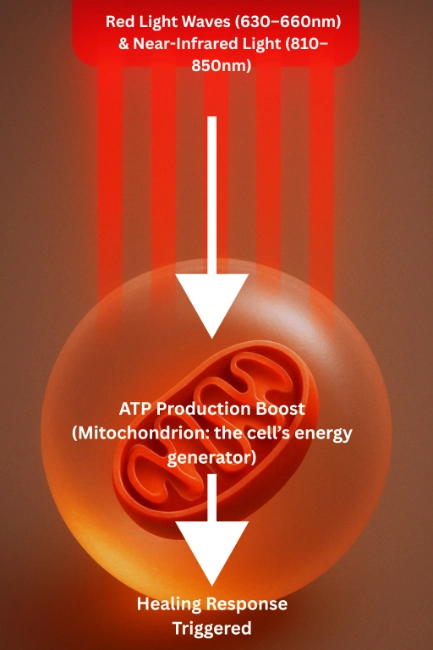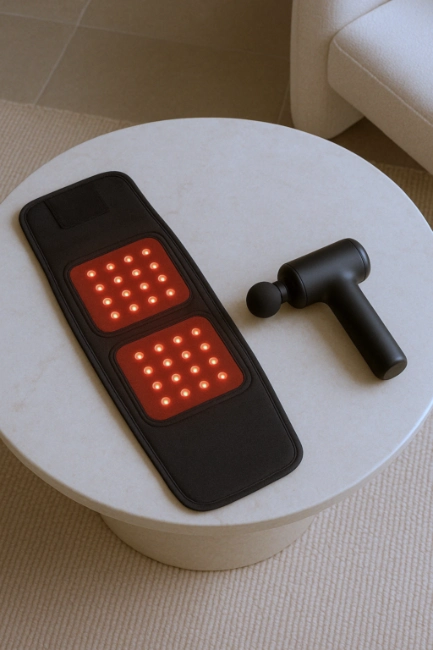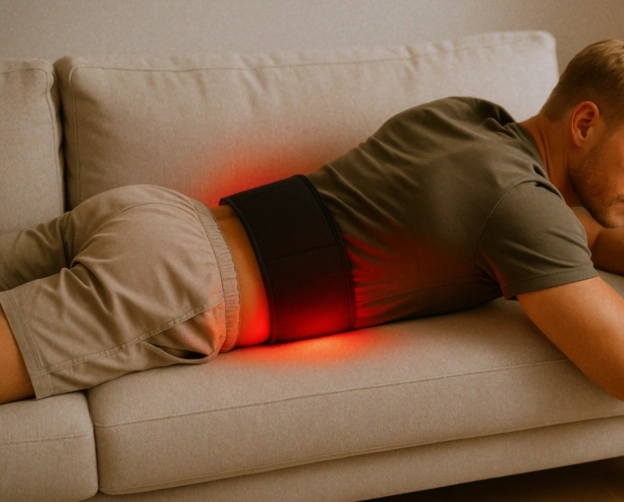Red Light Therapy for Lower Back Pain: Does It Work?

How Red Light Therapy Works for Lower Back Pain Relief
Lower back pain can feel like it steals momentum from your life. Your workouts, your sleep, your focus all suffer. Whether it's from sitting too long, lifting too hard, or just dealing with inflammation that’s been lingering for months (or even years). Finding a reliable fix isn’t always as simple as it sounds. Ice packs, stretching, NSAIDs…they help, but most of the time they are just surface level fixes. So it makes sense that more people are turning to red light therapy for lower back pain as a deeper, more restorative solution.
But let’s get this straight from the beginning: red light therapy isn’t a miracle tool. It’s a science backed modality that helps some people a lot. For others, it might leave them wondering if it’s doing anything at all. This article dives into how it works and what the research says. We’ll also go over how long it takes to notice relief, and whether it’s worth trying.
Spoiler Alert: for the right person with the right expectations, it just might be a game changer.
How Red Light Therapy Works for Lower Back Pain Relief
Red light therapy is also referred to as low level laser therapy or photobiomodulation. The process works by delivering specific wavelengths of red and near infrared light into your body’s tissues. Most devices you find while shopping online typically fall into the 630-660nm (red) and 810-850nm (near-infrared) wavelength range. This spectrum of light is powerful enough to penetrate your skin, your muscle, and even joint tissues.
Here’s what’s happening in your body beneath the surface:
Boosting cellular energy
The light photons get absorbed by your mitochondria, the ‘energy factories’ of your cells. This then helps ramp up production of ATP (adenosine triphosphate). ATP is responsible for powering everything from tissue repair to inflammation control. Simply explained, red light gives your cells the fuel they need to recover.
Modulating inflammation
With consistent exposure to these wavelengths, you can experience reduced inflammatory markers and also see improved circulation. Red light therapy also enhances oxygen delivery to stiff and often irritated areas. This matters a lot for lower back pain, where inflammation can often linger. Healing in this area is also slow due to heightened sensitivity.
Calming the pain response
Red light has also been shown to influence nerve cell membranes by reducing excitability in the pain sensitive neurons. It may also stimulate your body’s own natural endorphins and opioid-like compounds. All these dull that discomforting feeling.
This cellular and neurological combination is why many recovery focused people use red light therapy alongside stretching, myofascial release, or even contrast therapy. And for those already using red light therapy for testosterone or sleep optimization, lower back pain relief often becomes a bonus benefit.
Red Light Therapy for lower back pain. What the research says.
There’s no shortage of success stories but a lot of them are anecdotal. Many people describe how they feel less stiff, feel more mobile and even get to experience pain-free mornings after struggling for years. But here is what the data actually says…
There are many high-quality studies that offer strong support. In a very rigorously designed BMJ Open protocol trial, 148 people with chronic nonspecific low back pain received 12 sessions of photobiomodulation (red light therapy). The result? Pain scores significantly dropped,and these benefits were even tracked for up to one year! This wasn’t just a one-time fluke. It clearly showed a durable and long-term effect.
Another recent MLS laser study found that patients using a Multiwave Locked System laser experienced nearly 75% pain reduction. Those doing exercise therapy without any red light therapy improved by just 28% in comparison. The MLS tech used a blend of wavelengths to ensure that the light was able to penetrate deeper into the tissues.
The most notable study? The Erchonia clinical trials carried out in Melbourne Florida. It was significant enough to lead the FDA to issue full clearance for a red laser device made specifically for lower back pain. In the two double-blind studies they carried out with 120 participants, 80% of those treated with red light therapy reported 30% or greater pain reduction, compared to only 28% in the placebo group.
That said, not everyone has a breakthrough experience. For every user claiming “it gave me my mornings back,” there’s usually someone else asking, “why isn’t this working for me?” The results seem to depend heavily on the cause of the pain, the quality of the device, and lastly, whether the individual using the device is consistent with their sessions.
It’s why many people have started layering it with other therapies. In some cases where red light falls short, modalities like PEMF therapy (see: does PEMF therapy really work) can fill in the gaps. Or even best case, it will enhance the benefits when used together.
How Long Should You Use Red Light Therapy on Your Lower Back?
This is one of the most common pain points (pun intended). People want to know how much is enough… How long should they stick with it … and whether they’re wasting time if they don’t see quick results.
Based on both clinical trials and real user experience, here’s what seems to work best:
Session length
Start with 10 to 15 minutes per session. Once your body adapts, work up to 20-minute sessions.
Frequency
Aim for 3-5 sessions per week for the first 4-6 weeks. Daily use is fine if you're not experiencing any irritation.
Timeline for results
Some people notice an immediate change after the first session. This change is usually tied to warmth or feeling temporarily loose. But for actual pain reduction, it often takes 2-4 weeks to start seeing real progress. Long-term, the best results usually show up around the 8-12 week mark.
Device distance
Position your panel about 8-14 inches from your lower back.(This also depends on the beam angle and power of your device).
If you’re already someone who tracks metrics like your HRV, sleep quality, or recovery times, you might notice small improvements early on. But even if you don't track anything, and just go by feel… the key is consistency. It’s better to show up with short, regular sessions than go all in once a week.
People who are already stacking routines with sauna sessions, cold plunges… or even using other tools often pair red light with compression boots. Stiffness or swelling is usually part of the problem. If you're wondering where to start with those, here’s a deeper look at : are compression boots worth it.
And if you’re someone wondering whether more is better…Say, using your device in the morning and then again at night. You need to pay attention to guidance on what a safe frequency looks like. More on that here: Can you do red light therapy twice a day?
Is Red Light Therapy Worth It for Chronic Back Pain Relief?
The answer depends on what you’re expecting and how willing you are to commit to the process.
Let’s talk about investment first:
In-clinic red light therapy runs between $25-$85 per session. If you go a few times a week, that can add up fast. Some packages can range from $300-$600 for a specific bundled number of treatments.
Devices you use at home can vary wildly. Handhelds start around $100, while full-body panels or targeted lower back pads run $500-$2000+. The better ones deliver higher power output, more consistent coverage, and broader wavelength ranges to choose from..
Is it worth it?
If you’re dealing with stubborn, lingering back pain and want a non-invasive drug-free tool with minimal side effects, then yes… it’s hard to argue against trying it! Moreso if you’ve already done the physical therapy, changed your mattress, and gone down the anti-inflammatory supplement rabbit hole.
Still. When all is said and done, don’t expect magic.
You need:
A well-calibrated device (wavelength + irradiance matter)
A consistent schedule
Realistic goals (think “better mornings” or “reduced flare-ups”.... not overnight miracles)
Some people even combine it with hands-on tools like massage guns. If you’re curious how those stack up, we’ve explored : do massage guns help with soreness in the context of muscle recovery and deep tissue relief.
FAQs : Red Light Therapy for Lower Back Pain
How soon can I expect results?
Some people feel more relaxed or looser after just one or two sessions, but for true pain relief, most need at least 2-4 weeks of consistent use. Chronic issues may require 8+ weeks,
Can I use red light therapy alongside other recovery tools?
Absolutely. Red light therapy can be part of a broader protocol that includes stretching, cold therapy, mobility work, and even PEMF therapy. In fact, combining recovery methods may improve outcomes.
Are there side effects?
Side effects are rare but some people experience mild warmth, skin sensitivity, or slight redness at the treatment site. Using eye protection is also important if the light is near your face.
Does it work for everyone?
Not always. Around 50% of users have reported meaningful pain reduction, while others don’t notice much change. The effectiveness often depends on the type of pain, your device specs and how consistent you are.
Keep Exploring
If this article helped you navigate the pros and cons of red light for lower back pain, here are a few other deep dives to check out:
Feel the heat… literally. This deep dive breaks down whether these trendy portable saunas actually help with detox, stress relief, and recovery… or just make you sweat in place.
It’s not just for pain relief. Discover how red light can help with skin tone, eye puffiness, and collagen. Plus find out exactly how to use it without overdoing it.
Red light not delivering the results you hoped for? PEMF could be your next move. Learn what it is, how it compares, and why some people swear by it for deeper healing and full-body repair.



